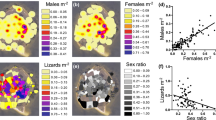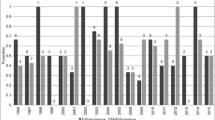Summary
Male thirteen-lined ground squirrels (Spermophilus tridecemlineatus) are subject to three forms of intrasexual competition: competition over location of spatially scattered females, overt conflict over access to those females, and sperm competition. The likelihood of both overt conflict and sperm competition varies between seasons; changes in male density, female density, and breeding synchrony were investigated as possible sources of that variability. Male density was artificially reduced mid-way through one mating season. The results of that experiment, as well as subsequent between-season comparisons, indicate that fluctuations of male density have hardly any effect on levels of overt conflict and sperm competition. By contrast, those forms of intrasexual competition are influenced strongly by female density and/or breeding synchrony.
Similar content being viewed by others
References
Alcock J (1980) Natural selection and the mating systems of solitary bees. Am Sci 68:146–153
Clutton-Brock T, Guinness F, Albon S (1982) Red deer. Behavior and ecology of two sexes. University of Chicago Press, Chicago
Darwin C (1871) The descent of man, and selection in relation to sex. Murray, London
Dobson S (1984) Environmental influences on sciurid mating systems. In: Murie J, Michener G (eds) Biology of ground dwelling squirrels. University of Nebraska Press, Lincoln, pp 227–249
Emlen S, Oring L (1977) Ecology, sexual selection and the evolution of mating systems. Science 198:215–233
Farentinos R (1980) Sexual solicitation of subordinate males by female tassel-eared squirrels (Sciurus aberti). J Mammal 61:337–341
Howard R (1981) Male age-size distribution and male mating success in bullforgs. In: Alexander R, Tinkle D (eds) Natural selection and social behavior. Chiron, New York, pp 61–77
Koford R (1982) Mating system of a territorial tree squirrel (Tamiasciurus douglasii) in California. J Mammal 63:274–283
Le Boeuf B (1974) Male-male competition and reproductive success in elephant seals. Am Zool 14:163–176
McLean I (1983) Paternal behaviour and killing of young in aretic ground squirrels. Anim Behav 31:32–44
Michener G (1983) Spring emergence schedules and vernal behavior of Richardson's ground squirrels: why do males emerge from hibernation before females? Behav Ecol Sociobiol 14:29–38
Murie J, Harris M (1978) Territoriality and dominance in male Columbian ground squirrels. (Spermophilus columbianus). Can J Zool 56:2402–2412
Schwagmeyer P (1984) Multiple mating and intersexual selection in the thirteen-lined ground squirrel. In: Murie J, Michener G (eds) Biology of ground-dwelling squirrels. University of Nebraska Press, Lincoln, pp 275–293
Schwagmeyer P, Brown C (1983) Factors affecting male-male competition in thirteen-lined ground squirrels. Behav Ecol Sociobiol 13:1–6
Sherman P, Morton M (1984) Demography of Belding's ground squirrels. Ecology 65:1617–1628
Thornhill R, Alcock J (1983) The evolution of insect mating systems. Harvard University Press, Cambridge
Trivers R (1972) Parental investment and sexual selection. In: Campbell B (ed) Sexual selection and the descent of man, 1871–1971. Aldine, Chicago, pp 136–179
Vestal B, McCarley H (1984) Spatial and social relations of kin in thirteen-lined and other ground squirrels. In: Murie J, Michener G (eds) Biology of ground-dwelling squirrels. University of Nebraska Press, Lincoln, pp 404–423
Wells K (1977) The social behaviour of anuran amphibians. Anim Behav 25:666–693
Author information
Authors and Affiliations
Rights and permissions
About this article
Cite this article
Schwagmeyer, P.L., Woontner, S.J. Mating competition in an asocial ground squirrel, Spermophilus tridecemlineatus . Behav Ecol Sociobiol 17, 291–296 (1985). https://doi.org/10.1007/BF00300149
Received:
Accepted:
Issue Date:
DOI: https://doi.org/10.1007/BF00300149




